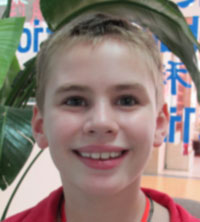Dillon - Cerebral palsy (South Africa) Posted on May 21, 2012
Name: Dillon Gustav Strydom 
Sex: Male
Country: South Africa
Age: 9
Diagnosis: Cerebral palsy
Admission Date: April 15, 2012
Days Admitted to Hospital: 30
Medical History:
Dillon was born via caesarean section at full term. The surgical procedure went smoothly. When Dillon was four months old, his parents discovered that he was unable to raise his right hand or grasp things. He was brought to the local hospital and received a CT of the head and the results showed, left cerebral hemisphere corresponding endocyst and porencephalic cyst. There was no expansion of the cerebral ventricle. The pathological changes may have come from an inner vascular injury. Dillon was then diagnosed with cerebral palsy. When he was 18 months old he could walk without support, but the right leg was weak and caused him to walk with an abnormal gait. The left arm had motor impairment. When Dillon was 3 years old, he underwent surgery for his legs. The surgery was successful and his walking gait improved. He suffered an epileptic seizure when he was 6 years old that lasted about 15 to 20 minutes. Dillon did not get any treatment after this initial seizure, but when he was 7 years old he suffered a second epileptic seizure which was similar to the first one. Dillon's parents brought him to their local hospital where he was given an EEG and the results showed potential epileptic signals. The left cerebral hemisphere was more obvious. Dillon was then prescribed sodium valproate and had the dosage adjusted. After this, there were no more epileptic seizures. In November 2010 the right forearm and wrist became rigid, which required surgery and the results were good.
Nervous System Examination:
Dillon was alert and his speech was clear. The memory, calculation ability and orientation were normal. Both pupils were equal in size, their diameter was 3.0mms. Both eyeballs could move almost normal and the pupils reacted normally to light stimulus. The tongue was averted to the left side. The movements of tongue muscle were normal to the left and right side, but the tongue muscle had difficulty with moving in an up or down motion. The neck had flexible movement. The shrugging ability of the right shoulder was weak. The muscle tone of the right forearm was slightly higher than normal. The right forearm had no pronation or supination action. The right upper limb had abnormal development, and it was shorter than the left upper limb. The muscle tone of all four limbs was almost normal. The muscle strength of the right upper limb was level 4. The muscle strength of the right lower limb was level 4+. The muscle strength of the left limbs was level 5. The abdominal reflexes were normal. The tendon reflex of the right upper limb was diminished. The tendon reflexes of the other limbs were normal. The sucking reflex was negative. The bilateral palm jaw reflex was negative. The bilateral Hoffmann's sign was negative. The right side Babinski's sign was positive. The left side Babinski's sign was negative. The left side of the body had normal deep, shallow, and epicritic sensation. The deep, shallow, and epicritic sensation on the right side of the body was diminished. The coordinated movement examination results of the left side of the body were normal. The coordinated movement examination results of the right side of the body were poor because of the weak muscle strength. The Romberg's sign was negative. There was mild claudication on the right side of the body while the patient walked.
Treatment:
After the admission, Dillon received the relevant examinations, and he was diagnosed with cerebral palsy. He received treatment to improve the blood circulation in order to increase the blood supply to the damaged nerves, and he was given treatment to nourish the neurons. He also had the nutritional intake enhanced.
Post Treatment:
Dillon's neural functioning has been gradually restored. The flexibility of the tongue has improved, and the tongue has the upward and downward movements. The muscle strength of the right upper limb has increased, and the arm can be raised more easily. The right forearm can do the pronation and supination movements. The fine motor skills of the right thumb, forefinger and middle finger have noticeably improved. The patient can point right thumb with forefinger and middle finger. Dillon can grasp chess with the right hand more accurately. The muscle strength of the right lower limb has increased. The balancing ability has improved. The right limbs have better overall movement ability.
Dillon's family member emailed to us:
Date: Mon, 18 Jun 2012
"Hello Lisa!!
Hope you are still well. Sure it is nice and warm, I miss the nice warm weather as it is getting cold now here in SA.
I watched Dillon last Thursday at his therapy and I can see a big improvement!! The therapist also says she are amazed at his improvement.
Minet (his mother) took him out of school and is doing home schooling with him so that she has time to do therapy with him every day. Once a week Dillon also goes to a therapist for therapy. As I stated, the therapist is amazed at the huge improvement that Dillon shows.
Dillon still has a long way to go, but we are all very happy with the improvement that he shows so far.
Dillon is still healthy and doing well (still naughty as always!!).
Please thank the doctors AND ALL THE NURSES AND ALL THE OTHER STAFF AS WELL (remember the cleaning ladies and the ladies that brought the food menus and the guy at reception)!
Please tell them all, I say hello and miss them all!! Give my email address to anybody that wants to email me.
Lots of joy and happiness for you!!
Darienne"
